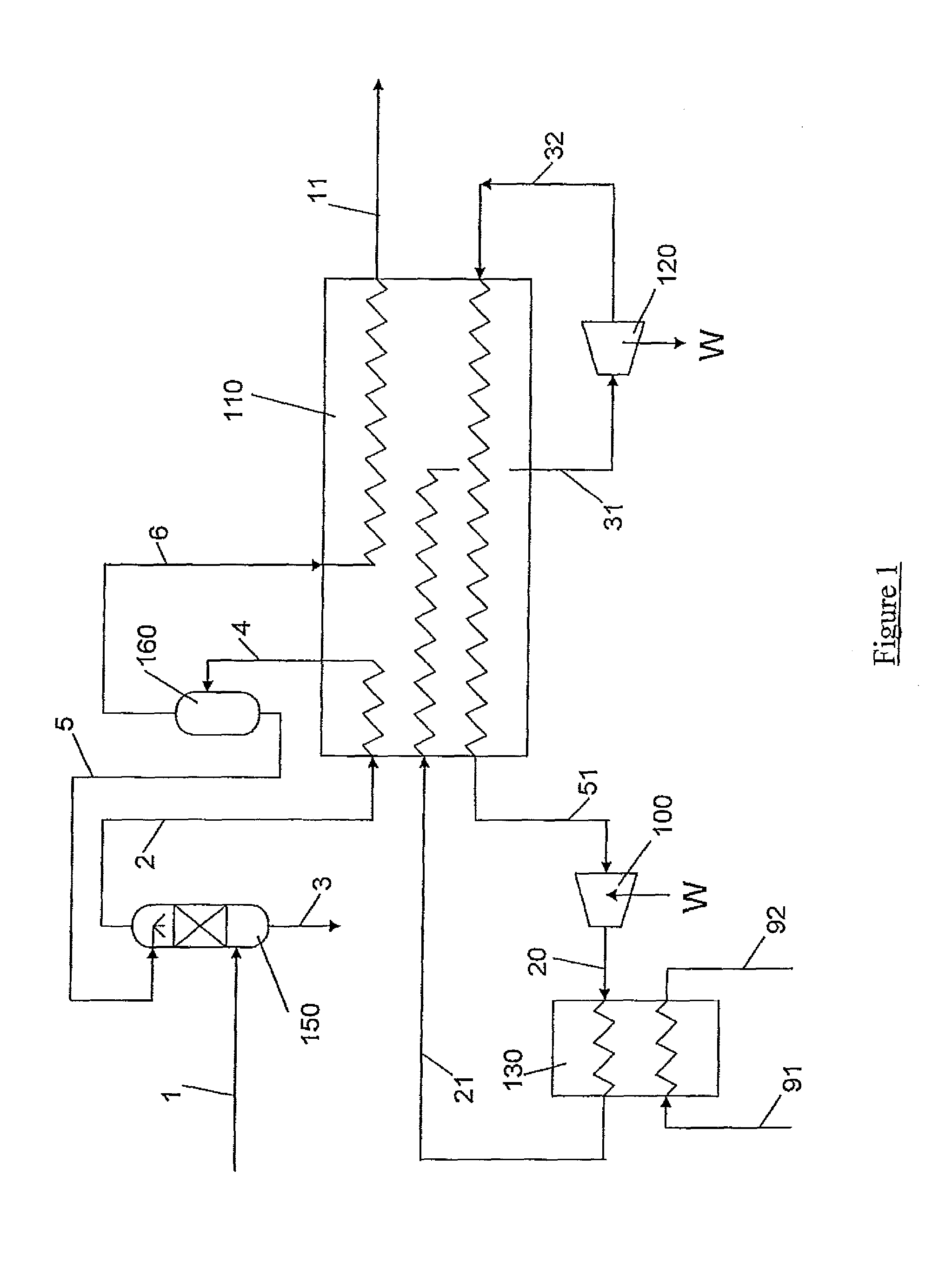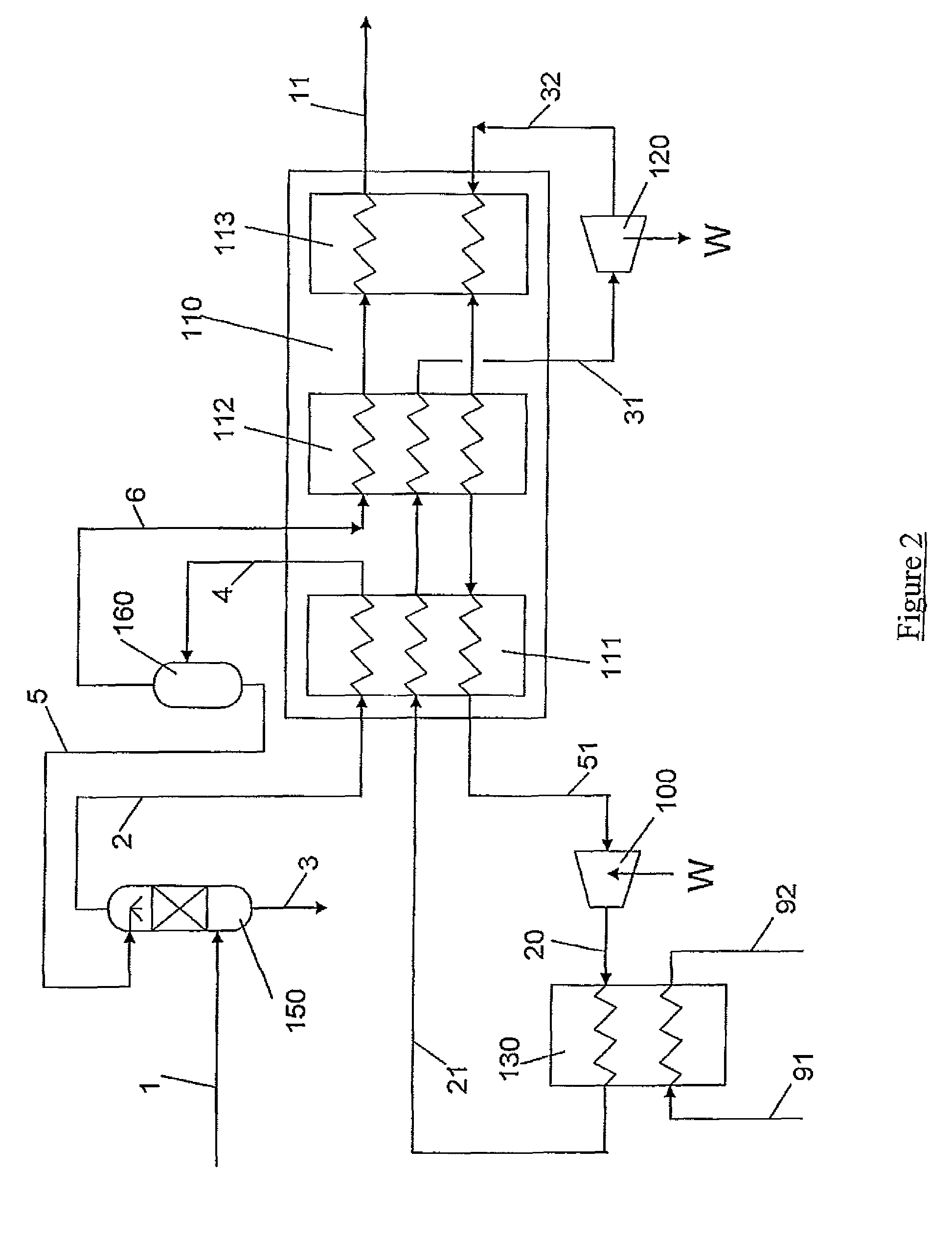Method and system for producing liquefied natural gas (LNG)
a technology of natural gas and liquefied gas, applied in the direction of refrigeration and liquidation, lighting and heating apparatus, solidification, etc., can solve the problems of unsuitable lng-based arrangements, unsatisfactory applications, and undesirable products, so as to improve the energy efficiency of the process, improve the efficiency of the gas expansion process, and optimise the application
- Summary
- Abstract
- Description
- Claims
- Application Information
AI Technical Summary
Benefits of technology
Problems solved by technology
Method used
Image
Examples
example 1
[0072]The example below shows natural gas with 90.4% methane by volume which is to be liquefied, where the invention is used to maximise the amount of liquid gas and at the same time minimise the by-production of unstable hydrocarbon liquid with a high content of ethane, propane and butane. The stream data refer to FIG. 1, 2, 3, 4 or 5.
[0073]
Stream No.12345611Gas fraction 1.00 1.00 0.00 0.95 0.00 1.00 0.00Temperature 40.0 19.2 35.9 −20.0 −20.0 −20.0 −155.0(° C.)Pressure2740273827452725273027232655(kPa abs)Mole flow42324422 444422 23541854185(kmol / h)Mass flow78980 87539 341087539 11969 75541 75541 (kg / h)Molefraction (%)Nitrogen0.51%0.49%0.02%0.49% 0.03%0.52%0.52%Methane90.4%87.4%11.8%87.4% 19.5%91.3%91.3%Ethane4.38%4.53%2.58%4.53% 6.84%4.40%4.40%Propane2.29%2.95%4.17%2.95%15.04%2.27%2.27%i-Butane0.68%1.25%2.80%1.25%11.92%0.65%0.65%n-Butane0.66%1.52%3.79%1.52%17.30%0.62%0.62%i-Pentane0.17%0.70%2.52%0.70%10.57%0.14%0.14%n-Pentane0.17%0.79%3.61%0.79%12.49%...
example 2-5
[0074]The examples below shows example of the percentage of feed gas pr. component in some of the key streams with the present invention, for different methane content in feed gas.
[0075]
PERCENT OF FEED GAS FOR EACH STREAM FORA 97 VOL % METHANE FEED GASCOLUMNCOMPONENTREFLUXLNGCONDENSATEOVERHEADN24.4%100.0%0.0%104.4%C110.7%99.9%0.1%110.6%C249.1%99.4%0.6%148.5%C3146.3%98.2%1.8%244.5%C4363.7%94.7%5.3%458.3%C5701.3%68.0%31.9%769.3%C611.1%0.3%99.7%11.4%C70.1%0.0%100.0%0.1%C80.0%0.0%100.0%0.0%C90.0%0.0%100.0%0.0% C10+0.0%0.0%100.0%0.0%
[0076]
PERCENT OF FEED GAS FOR EACH STREAM FORA 95 VOL % METHANE FEED GASCOLUMNCOMPONENTREFLUXLNGCONDENSATEOVERHEADN23.1%100.0%0.0%103.1%C18.6%99.9%0.1%108.5%C245.7%99.4%0.6%145.2%C3151.6%98.1%1.9%249.7%C4393.5%91.2%8.8%484.6%C5129.8%11.1%88.9%140.9%C60.8%0.0%100.0%0.9%C70.0%0.0%100.0%0.0%C80.0%0.0%100.0%0.0%C90.0%0.0%0.0%0.0% C10+0.0%0.0%0.0%0.0%
[0077]
PERCENT OF FEED GAS FOR EACH STREAM FORA 93 VOL % METHANE FEED GASCOLUMNCOMPONENTREFLUXLNGCONDENSATEOVERHEADN...
PUM
 Login to View More
Login to View More Abstract
Description
Claims
Application Information
 Login to View More
Login to View More - R&D
- Intellectual Property
- Life Sciences
- Materials
- Tech Scout
- Unparalleled Data Quality
- Higher Quality Content
- 60% Fewer Hallucinations
Browse by: Latest US Patents, China's latest patents, Technical Efficacy Thesaurus, Application Domain, Technology Topic, Popular Technical Reports.
© 2025 PatSnap. All rights reserved.Legal|Privacy policy|Modern Slavery Act Transparency Statement|Sitemap|About US| Contact US: help@patsnap.com



